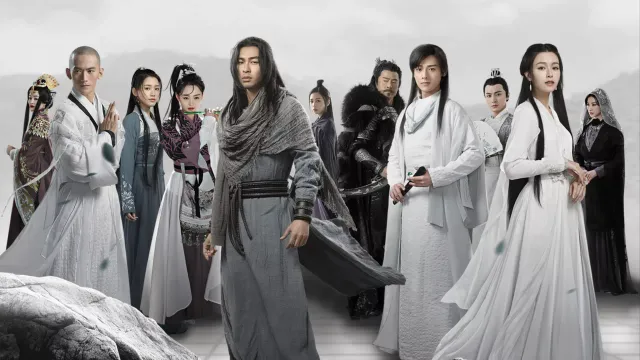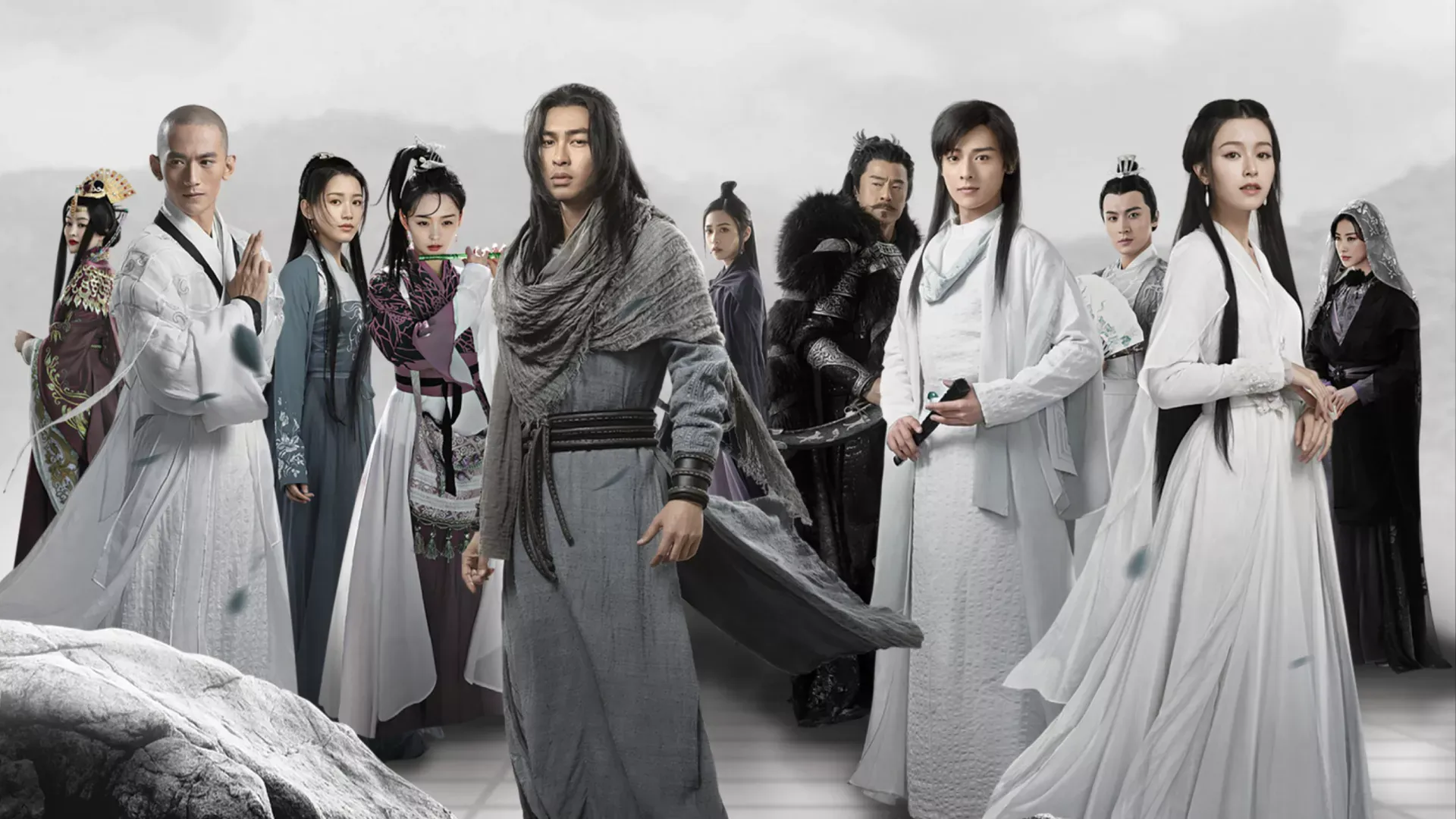Duan Clan of Dali (simplified: 大理段氏, traditional: 大理段氏, pinyin: Dàlǐ Duàn Shì) was a prestigious martial arts family and royal house that ruled the Kingdom of Dali in Yunnan. Despite being a royal family, they never neglected their martial arts heritage, instead becoming increasingly diligent in their practice, with most royal family members being accomplished martial artists.
This dedication to martial excellence alongside imperial duties distinguished them from other royal houses, as they viewed martial cultivation as inseparable from effective governance.
The Duan Clan originated from a Central Plains martial arts family and established their kingdom in 937 CE during the Later Jin dynasty1 of the Five Dynasties period.2 The Kingdom of Dali was a Buddhist state, with emperors who were devout Buddhists often abdicating the throne to become monks and enter Tianlong Temple to study more profound martial arts.
The clan’s signature martial arts, the Spirit Blades of Six Meridians and One Yang Finger, were among the most renowned techniques in the jianghu,3 known for their devastating power and unique characteristics.
History
Foundation
Duan Siping established the Kingdom of Dali in 937 CE, marking the start of the Duan Clan as an influential faction. Originally from a Central Plains martial arts family, Duan Siping was not only a martial arts master but also a devout Buddhist who created the unique political system of combining religion and state.
Duan Siping established Tianlong Temple and positioned Buddhism as the state religion, creating a theocratic political system that would become characteristic of the Dali Kingdom. This unique combination of martial arts prowess and religious devotion would define the clan’s identity for generations.
Martial arts development
Duan Siping was a martial arts genius who created three supreme techniques: the Life’s Vicissitude Meditation, One Yang Finger, and Spirit Blades of Six Meridians. These techniques would become the foundation of the clan’s martial arts heritage and establish their reputation as one of the most powerful martial arts families in the world.
The clan’s martial arts were unique in that they combined Buddhist philosophy with practical combat techniques, creating a system that emphasized both spiritual cultivation and martial effectiveness.
Political development
During the Song Dynasty,4 the Dali Kingdom maintained tributary relations with the imperial court. Emperor Song Taizu officially recognised Dali’s sovereignty over territories south of the Dadu River, establishing a stable political arrangement that allowed the kingdom to prosper for over three centuries.
The kingdom faced its greatest challenge during the Mongol expansion.5 In 1254 CE, Kublai Khan’s forces captured the Dali capital, ending the kingdom’s independence after 317 years of Duan rule. Following the conquest, the Mongol ;Yuan Dynasty6 appointed members of the Duan Clan as hereditary governors of Dali, allowing them to maintain some authority over their ancestral lands until the Ming Dynasty’s7 establishment in 1382 CE.
Organisation
Leadership
The Duan Clan operated as both a royal family and a martial arts sect, with leadership positions often overlapping between political and martial authority. The emperor would typically be the most powerful martial artist in the clan, though some would abdicate to focus entirely on martial arts cultivation.
Tianlong Temple
Tianlong Temple served as both the spiritual center of the Dali Kingdom and the martial arts headquarters of the Duan Clan. It was here that clan members would study advanced techniques and where retired emperors would continue their martial arts development.
The temple housed the clan’s most precious martial arts manuals and served as a training ground for the most talented members of the family.
Royal family
The Duan Clan’s royal family members were all accomplished martial artists, with each generation producing several masters. This unique combination of political power and martial prowess made the clan one of the most influential forces in the jianghu.
Royal succession
The Duan Clan maintained a unique succession system where emperors would often abdicate the throne to become monks, entering Tianlong Temple to pursue higher martial arts and spiritual enlightenment. This tradition ensured that the clan’s martial arts heritage was preserved and developed across generations.
Four Bodyguards
Elite clan members were protected by skilled martial artists known as bodyguards.
Emperor Duan Zhengming’s three highest-ranked ministers served as his personal bodyguards, whilst Duan Zhengchun was protected by the Four Bodyguards of the Southern March: Fan Hua, Hua Hegen, Ba Tianshi, and Zhu Danchen. This system ensured that the royal family remained protected whilst maintaining the clan’s martial traditions.
After Duan Zhixing abdicated and became Great Master Yideng, his four most loyal ministers followed him into religious life, disguising themselves as common tradesmen while serving as his guardians: Chu Dongshan (the Fisherman), Zhang Shaoshou (the Woodcutter), Wu Santong (the Farmer), and Zhu Ziliu (the Scholar). These former high-ranking officials—a naval admiral, army general, palace guard chief, and premier respectively—demonstrated extraordinary loyalty by abandoning their positions to protect their master.
Martial arts abilities
One Yang Finger
The One Yang Finger (一阳指 – Yī Yáng Zhǐ) was created by the clan’s ancestor Duan Jianwei (段俭魏 – Duàn Jiǎnwèi), though some sources attribute its creation to Duan Siping (段思平 – Duàn Sīpíng) himself. A master of both martial arts and the Book of Changes,8 Duan Jianwei believed that “of the fifty great numbers, losing one creates infinite transformations.” This missing “one” was considered the key to martial arts mastery, and this profound understanding allowed practitioners to achieve breakthrough progress in their martial cultivation.
The One Yang Finger possessed extraordinary and mystical properties, capable of directing pure yang internal energy through the index finger with devastating precision. The technique could inflict severe damage to opponents or, conversely, restrain them without causing any harm whatsoever. This dual capability made it one of the most versatile techniques in the martial arts world.
Spirit Blades of Six Meridians
The Spirit Blades of Six Meridians (六脉神剑 – Liù Mài Shén Jiàn) was not an actual sword but rather a technique that transformed the power of the One Yang Finger into sword energy. It was a formless sword energy that could be considered an invisible sword.
The “six meridians” referred to the six meridians of the hand: the Taiyin Lung Meridian, Jueyin Pericardium Meridian, Shaoyin Heart Meridian, Taiyang Small Intestine Meridian, Yangming Stomach Meridian, and Shaoyang Triple Burner Meridian.
According to legend, Duan Siping, the founding emperor of Dali, had extraordinary experiences and possessed supreme neili, allowing him to master the One Yang Finger with ease. However, he preferred sword techniques and, through continuous effort, discovered and created six sets of sword techniques.
In sword duels, he won more than he lost, but he remained unsatisfied, hoping to make his sword techniques invincible. He realized that the six sword techniques had no connection between them, creating vulnerabilities during transitions. However, his exceptional intelligence led him to develop the method of using fingers as swords.
Using extremely pure Yang energy and the foundation of the One Yang Finger, he could shoot sword energy from his fingers to replace real swords. The flexibility of wrist movement eliminated the vulnerabilities in sword technique transitions, and the six sword techniques could be used in combination, making them much more powerful than using a single sword technique.
From then on, Duan Siping became famous throughout the world, and the Spirit Blades of Six Meridians became invincible in the jianghu. However, because the Spirit Blades of Six Meridians required profound neili as its foundation, few in later generations could master it.
Duan Clan Swordplay
The Duan Clan Swordplay (段家剑法 – Duàn Jiā Jiàn Fǎ) was created by Duan Siping himself. As a military general by background, this sword technique was well-suited for battlefield combat. The technique was characterized by broad, sweeping movements with magnificent momentum. Each sword thrust had the power to shatter stone and create storms.
This was a very practical martial art, and the Shaoshang Sword of the Spirit Blades of Six Meridians evolved from it.
Life’s Vicissitude Meditation
The Life’s Vicissitude Meditation (枯荣禅功 – Kū Róng Chán Gōng) was another supreme technique created by Duan Siping. This technique combined Buddhist meditation with martial arts cultivation, allowing practitioners to achieve both spiritual enlightenment and martial prowess.
Notable members
Duan Siping
Duan Siping (段思平 – Duàn Sīpíng) was the founding emperor of the Kingdom of Dali and creator of the clan’s three supreme martial arts techniques. As both the kingdom’s founder and a martial arts grandmaster, Duan Siping created One Yang Finger, Spirit Blades of Six Meridians, and Life’s Vicissitude Meditation, establishing himself as the supreme martial artist of his era.
He was deeply versed in Buddhist teachings and founded Tianlong Temple and made Buddhism as the state religion, creating the unique theocratic political system that would define the Dali Kingdom for centuries.
Duan Zhengming
Duan Zhengming (段正明 – Duàn Zhèngmíng), regnal name Emperor Baoding of Dali (保定帝 – Bǎodìng Dì), the elder brother of Duan Zhengchun and uncle of Duan Yu. He was a powerful martial artist who mastered the clan’s supreme technique, the One Yang Finger, and was considered the clan’s foremost secular martial artist. Later, he became a monk at Tianlong Temple with the Dharma name Ben Chen.
Duan Zhengchun
Duan Zhengchun (段正淳 – Duàn Zhèngchún), Defender-Prince of the Southern March of Dali (镇南王 – Zhènnán Wáng), Duan Yu’s adoptive father and husband of Dao Baifeng. He was deeply trusted by Emperor Baoding and was known for his romantic relationships with Qin Hongmian, Gan Baobao, Ruan Xingzhu, Li Qingluo, and Kang Min. He was the father of Mu Wanqing, Zhong Ling, Azhu, Azi, and Wang Yuyan.
Duan Yanqing
Duan Yanqing (段延庆 – Duàn Yánqìng) was the Crown Prince of Dali who was exiled when the treacherous minister Yang Yizhen usurped the throne after internal turmoil in Dali. Due to his identity, he was hunted by many parties and eventually suffered multiple knife wounds. Though he survived, his face was disfigured and his legs were crippled, leaving him able to communicate only through ventriloquism.
Later, he forced himself to practice the clan’s martial arts and eventually became a first-class expert in the Western Xia’s First-Class Hall despite his disability. After mastering his martial arts, he began a campaign of brutal revenge against those who had hunted him, earning the nickname Evil Beyond Measure due to his cruel methods. His martial arts included ventriloquism and the One Yang Finger.
Duan Yu
Duan Yu (段誉 – Duàn Yù), the adoptive son of Duan Zhengchun, received excellent education from childhood and was well-versed in literature and etiquette. He was gentle, refined, honest, humble, kind, and considerate of others, though his bookish nature often led others to mock him as a scholar. He was learned, handsome, and kind, but also stubborn and detested killing and conflict.
Duan Zhixing
Duan Zhixing (段智兴 – Duàn Zhìxīng), known as the Southern Emperor among the Five Greats. After he abadicated his throne, he took the Dharma name Yideng and the epithet of the Southern Monk. He was a supreme martial artist who mastered the Nine Yin Manual and the Quanzhen feat Innate Skill on top of the Duan Clan’s One Yang Finger.
Great Master Kurong
Great Master Kurong (枯荣大师 – Kū Róng Dàshī), a royal relative of the Kingdom of Dali who became a monk at Tianlong Temple in his youth. He was a powerful martial artist with high moral character and prestige, and keeper of the Spirit Blades of Six Meridians manual.
Relationships
Political Alliances
The Duan Clan maintained complex relationships with neighbouring powers throughout their reign. Their tributary status with the Song Dynasty provided political protection whilst allowing considerable autonomy. The clan’s Buddhist orientation fostered peaceful relations with Tibet and other Buddhist kingdoms in the region, creating a stable political environment that allowed their martial arts to flourish.
Martial World Connections
As one of the most respected orthodox factions, the Duan Clan enjoyed friendly relations with Shaolin Order, the Beggars’ Guild, and other righteous sects. Their reputation for moral conduct and martial excellence earned them widespread respect throughout the jianghu, with their techniques being considered among the pinnacle of orthodox martial arts.
Internal Conflicts
The clan faced significant internal strife due to succession disputes and the machinations of powerful ministers like Gao Shengtai. The conflict between the main imperial line and the exiled branch represented by Duan Yanqing created lasting tensions that influenced clan politics for generations. These internal divisions reflected the challenges of balancing political power with martial arts cultivation.
Behind the scenes
The Duan Clan of Dali represents one of Jin Yong’s most sophisticated explorations of the relationship between political power and martial arts. The clan’s unique position as both a royal family and a martial arts faction creates fascinating dynamics that explore themes of duty, power, and spiritual cultivation.
The character of Duan Yanqing represents one of Jin Yong’s most tragic villains, a man whose legitimate claim to power was stolen from him, leading to his transformation into a figure of pure vengeance. His story explores themes of justice, revenge, and the corrupting influence of power.
See also
- Jin Yong factions
- Demi-Gods and Semi-Devils factions
- The Legend of the Condor Heroes factions
- Duan Siping – Founding emperor and creator of the clan’s supreme techniques
- Duan Yu – Crown prince and protagonist of Demi-Gods and Semi-Devils
- Duan Zhixing – Southern Emperor and one of the Five Greats
- Tianlong Temple – Spiritual and martial arts center of the Duan Clan
- Spirit Blades of Six Meridians – The clan’s most powerful martial art
- One Yang Finger – The clan’s signature technique
Footnotes
-
后晋 – Hòu Jìn. The Later Jin dynasty (936-947 CE), one of the Five Dynasties in Chinese history. See Wikipedia. ↩
-
五代十国 – Wǔdài Shíguó. The Five Dynasties and Ten Kingdoms period (907-979 CE), a period of political disunity in Chinese history. See Wikipedia. ↩
-
江湖 – jiānghú. The world of martial arts. A sub-society involving all who are related to the martial arts scene. What is jianghu? ↩
-
宋 – Sòng. Dynasty ruled by the Han Chinese under the House of Zhao from 960 to 1279 CE, referred to as Northern Song before losing the northern territories to Jin invasion, and Southern Song after the capital moved south. See Wikipedia. ↩
-
蒙古帝国 – Měnggǔ Dìguó. Mongol Empire was largest contiguous empire in history, spanning from 1206 to 1635 CE. See Wikipedia. ↩
-
元朝 – Yuán Cháo. Dynasty established by Kublai Khan and ruled by the Mongols from 1271 to 1368 CE. See Wikipedia. ↩
-
明朝 – Míng Cháo. Dynasty that overthrew Mongol rule and re-established Han-Chinese rule from 1368 to 1644 CE. See Wikipedia. ↩
-
易经 – Yìjīng. An ancient Chinese divination text used for philosophical guidance and fortune-telling, One of the Five Classics, also known as Yijing or I Ching. See Wikipedia. ↩


